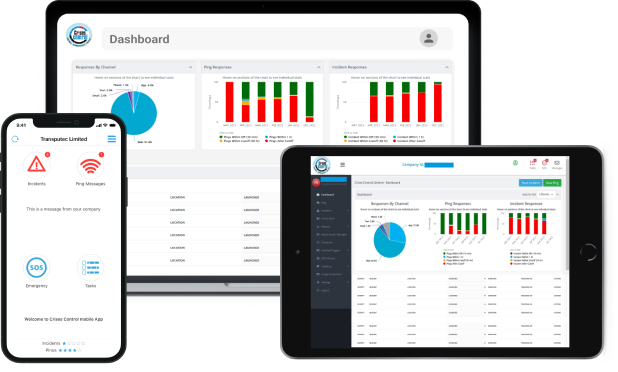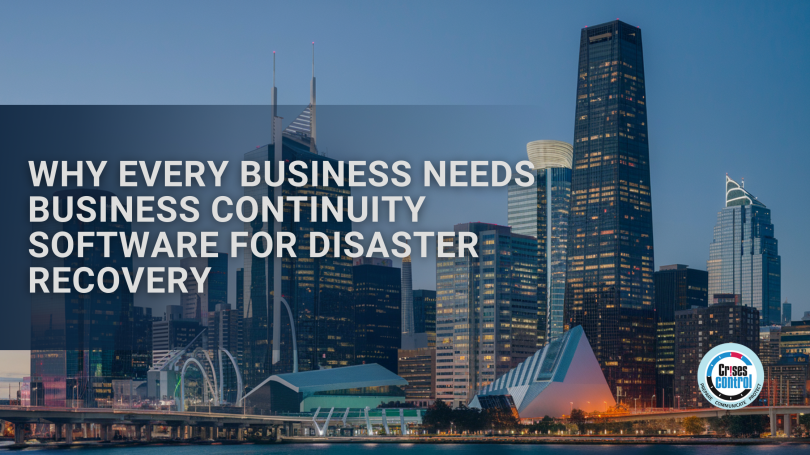Written by Anneri Fourie | Crises Control Executive
Disruptions are inevitable. Whether it’s a cyberattack, a power outage, or a natural disaster, businesses must be prepared to respond quickly and effectively. The real question isn’t if a crisis will occur, but when—and how well your organisation can recover. Without a solid disaster recovery plan in place, the consequences can be severe: prolonged downtime, financial losses, reputational damage, and even regulatory penalties.
Business continuity software is no longer just a safety net, it’s an essential tool for organisations that want to stay operational in the face of disruption. Instead of relying on outdated paper-based plans or scattered manual processes, companies need a solution that integrates communication, incident management, and recovery strategies into one seamless platform.
In this blog, we’ll explore why business continuity software is critical for disaster recovery and how Crises Control provides the tools organisations need to safeguard their operations.
The Growing Need for Business Continuity Software in Disaster Recovery
When disaster strikes, the first few minutes are crucial. Delayed decision-making, communication breakdowns, and disjointed response efforts can quickly escalate a manageable issue into a full-blown crisis. The cost of unpreparedness is high:
- According to industry reports, 93% of businesses that suffer significant data loss for 10 days or more go bankrupt within a year.
- The average cost of unplanned downtime is estimated at $5,600 per minute, making rapid recovery essential.
Many businesses still rely on traditional disaster recovery plans; static documents that sit in a folder until needed. These plans often fail when put to the test, because they rely on manual communication, lack real-time coordination, and don’t provide the agility needed for fast response.
Business continuity software eliminates these issues by automating workflows, providing real-time alerts, and ensuring everyone knows their role in a crisis. With a structured, technology-driven approach, businesses can react faster and more effectively, minimising the impact of disruptions.
Key Features of Business Continuity Software for Disaster Recovery
A robust business continuity platform provides more than just a backup plan. It ensures organisations can execute their response and recovery strategies with speed and precision. Here are some essential features:
1. Automated Alerts and Communication
- Multi-channel notifications (SMS, email, push notifications, voice calls) ensure that the right people receive critical updates immediately.
- Two-way communication allows teams to report status updates in real time.
- Escalation workflows ensure messages reach key decision-makers if the initial recipients don’t respond.
2. Incident Management and Task Automation
- Incident management software enables teams to coordinate their response efficiently.
- Automated workflows reduce human error and ensure recovery steps are followed in the correct order.
- Role-based access controls allow only authorised personnel to carry out specific actions.
3. Cloud-Based Accessibility and Data Protection
- Secure cloud storage ensures that critical business continuity plans are always accessible, even if local systems fail.
- Remote accessibility allows crisis teams to manage incidents from anywhere.
- Automated data backups protect against data loss and ensure regulatory compliance.
4. Real-Time Monitoring and Reporting
- Live dashboards provide a complete overview of ongoing incidents and response activities.
- Performance analytics help businesses identify areas for improvement in their disaster recovery strategy.
- Post-incident reporting supports compliance and audit requirements.
How Business Continuity Software Enhances Disaster Recovery
Many organisations struggle with disaster recovery, because their response plans aren’t integrated into their daily operations. Business continuity software bridges this gap, making preparedness, response, and recovery part of a continuous process rather than a one-time effort.
1. Reducing Downtime and Revenue Loss
The faster a business can recover, the less impact a disruption has. Business continuity software automates key processes, ensuring incidents are identified and addressed quickly. Instead of scrambling to coordinate a response, organisations can execute predefined recovery plans immediately, significantly reducing downtime and financial losses.
2. Improving Decision-Making During a Crisis
When a crisis unfolds, leadership teams must make quick, informed decisions. Business continuity software provides real-time situational awareness, allowing managers to see the full scope of an incident, track response progress, and adjust strategies as needed.
3. Ensuring Compliance and Regulatory Adherence
Industries such as finance, healthcare, and critical infrastructure must adhere to strict regulatory standards for business continuity and disaster recovery. Business continuity software ensures that all recovery steps are documented, tested, and aligned with compliance requirements, reducing the risk of fines and legal repercussions.
4. Strengthening Employee and Stakeholder Confidence
A well-prepared business fosters trust. Employees feel more secure knowing there’s a clear plan in place, customers appreciate reliability, and investors gain confidence in the company’s ability to manage risks effectively.
How Crises Control Supports Effective Disaster Recovery
At Crises Control, we specialise in helping businesses build resilience with a comprehensive, cloud-based business continuity solution. Our platform ensures organisations remain operational during disruptions, enabling them to respond to crises with confidence.
Why Businesses Choose Crises Control:
- Ping Mass Notification System: Instantly alerts employees and stakeholders through multiple channels.
- Incident Management Software: Automates crisis response for a structured and efficient recovery.
- Task Manager: Assigns and tracks recovery actions in real-time, reducing response time.
- Cloud-Based Access: Ensures critical plans and documents are always available, even if local servers fail.
- Easy Integration: Works seamlessly with existing enterprise systems.
- Detailed Reporting & Audit Trails: Supports regulatory compliance with comprehensive incident logs.
The Cost of Not Having Business Continuity Software
Failing to invest in a robust continuity plan can be costly. Without business continuity software:
- Response times are slower, leading to longer operational disruptions.
- Communication breakdowns result in confusion and delays.
- Compliance risks increase, exposing businesses to potential fines and legal action.
- Customer trust declines, damaging brand reputation and long-term viability.
Many businesses don’t realise the true cost of downtime until they experience it first-hand. Investing in business continuity software is not just about protecting operations, it’s about safeguarding the future of the business.
Conclusion: Secure Your Business with Crises Control
Disasters are unavoidable, but their impact doesn’t have to be catastrophic. A well-prepared organisation can navigate disruptions with minimal damage, ensuring business continuity and operational resilience.
Crises Control provides a powerful, all-in-one business continuity and incident management solution designed to help organisations respond to crises swiftly and effectively.
Contact us today to get a free personalised demo and see how Crises Control can transform your disaster recovery strategy.
Request a FREE Demo








